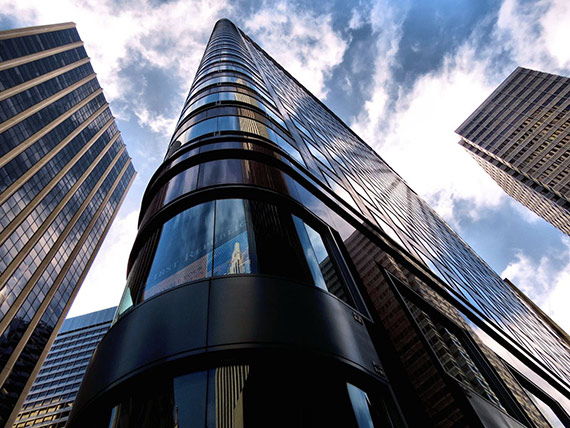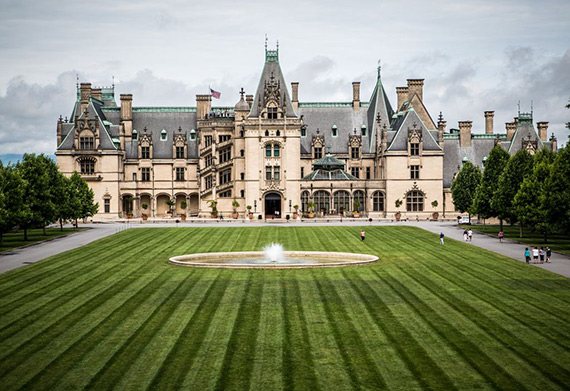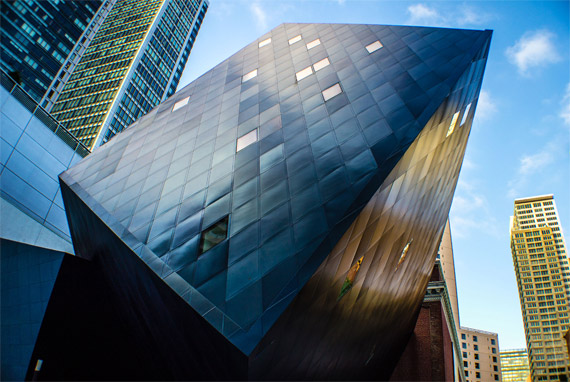In photography, as well as in any other visual art form, light plays a key role, and it should be considered a critical compositional element. Lighting for architectural photography, as well as for interior photography, can be very demanding, because the light defines the space or structure of the building. Lighting for interiors is much more controllable than for exteriors; however, in both situations the architectural photographer must be able to “take control”–even when dealing with the sun.
Working as a Chicago architectural photographer for over 30 years, I have learned patience! In the Midwest, and Chicago in particular, the required conditions for architectural exterior photography can come infrequently, as one must work around unpredictable weather and cloud formations that develop very quickly due to the lake effect; not to mention the high humidity, which produces grey skies. Many times I have had to wait days or even weeks for the proper conditions.

“SanFrancisco” captured by PictureSocial member Joe Machuta
A few years ago, I also set up an office in Arizona with the assumption that, as a Phoenix architectural photographer, my weather woes would be over. However, I had to learn the weather idiosyncrasies of that area as well; namely the monsoon season, when most every afternoon, from July through August, the sky becomes cloudy, the light dissipates, and there is a high probability of rain.
I bring this up as background so one may better understand the challenges and parameters in which high-quality architectural photographs are made. In the studio, everything is controlled. The architectural photographer, on the other hand, must learn to deal with unpredictable and seemingly uncontrollable circumstances in order to produce the dramatic images that the client expects.
Sunlight is essential when photographing architectural exteriors, and the architectural photographer must be able to “control” the light at all times. This is a challenge, because the only light source he or she has to work with is the sun; “controlling” the sun can seem paradoxical. However, one must control that which he or she can control in order to produce the strongest architectural photograph possible. These controllable elements are time of year, type of day, time of day, and quality of light.

“Closer View of The Biltmore from the Rampe Douce” captured by PictureSocial member Earl E. Gibson
Directional light is always important when photographing architecture, so it stands to reason that one must wait for the best conditions to photograph; the clarity of the light, the type of sky, the direction of the sun and the quality of the light (hard or diffused) are all critical factors when photographing architecture and must be given serious consideration.
Direction of the elevation to be photographed with respect to the sun is critical for separating the planes of the structure and bringing out the textures and details of the building. Front lighting, or light that is behind the camera, is not acceptable in most cases. One should always select the time of day when the sun is at approximately a 45-degree angle to the elevation being photographed. Usually, the best light is within a time frame of a few hours after sunrise or a few hours before sunset (as long as the orientation of the building allows for it). The “golden hour” light–just after sunrise or just before sunset–is even better because the sun’s low angle adds warmth, mood, and drama to the photograph with long, deep shadows; something I like to use in the foreground if possible. The quality of this “golden hour” light is also much softer than the harsher sunlight in the middle of the day.

“Museum in SF” captured by PictureSocial member Mohamed Mahmoud Taman
A north facing view can only be photographed with ideal light within a short time span in the summer, as close to the summer solstice as possible. At that time of year the sun is at its highest position, and it is also the longest day of the year. The north light deteriorates each day afterwards as it travels in a more southerly direction.
Learning to work with the sun and the weather is an essential requirement in producing a high-quality architectural photographs. Many clients probably have no idea what goes into that “perfect” day. The professional architectural photographer must be patient and disciplined in order to take control of the uncontrollable; there is nothing accidental in the fine architectural photograph.
About the Author:
Paul Schlismann is a professional architectural photographer and has specialized in photographing architecture and interiors for the professional architect, interior design, hospitality, architectural product and corporate markets since 1980. Having been established in his career for over 30 years as a Chicago architectural photographer, he now also has an office located in Arizona and is working in Chicago, Phoenix, Las Vegas, and California statewide.
Go to full article: Sun and Lighting for Architectural Photography
What are your thoughts on this article? Join the discussion on Facebook
PictureCorrect subscribers can also learn more today with our #1 bestseller: The Photography Tutorial eBook
The post Sun and Lighting for Architectural Photography appeared first on PictureCorrect.